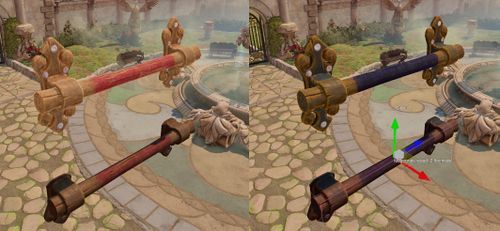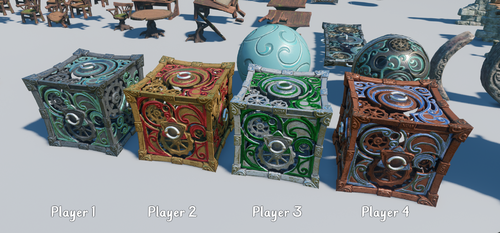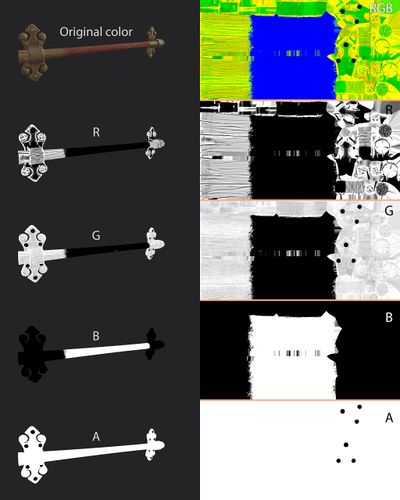Difference between pages "3D Asset Workflow: Completed asset checklist" and "3D Asset Workflow: Tintmask"
(Difference between pages)
m |
m |
||
| Line 7: | Line 7: | ||
= Summary = | = Summary = | ||
| − | * | + | * A tintmask is a texture, in which different areas of the model are masked to separate color channels |
| + | ** The albedo of the model can then be colored in the Editor using these channels | ||
| + | * Tintmasks are very useful for creating multiple differently colored variations of the same model, without having to make [[3D Asset Workflow: Alternative Textures|Alternative Textures]] for all of them | ||
| + | * When using tintmasks, '''it's important to always adjust the default colors to be nice and usable as is''' | ||
| + | ** Otherwise the model will be black, and additional adjusting is needed | ||
| + | * Some general Editor tips for tintmasks can be found from [[3D_Asset_Workflow:_General_Tips#Editor|3D Asset Workflow: General Tips#Editor]] | ||
| − | + | [[File:tintmask_example_ledgegrabs.jpg|500px]] | |
| − | + | [[File:Trine 4 wizard box tintmask.png|500px]] | |
| − | |||
| − | |||
| − | |||
| − | |||
| − | |||
| − | |||
| − | |||
| − | |||
| − | |||
| − | |||
| − | |||
| − | |||
| − | |||
| − | |||
| − | |||
| − | |||
| − | |||
| − | |||
| − | |||
| − | |||
| − | |||
| − | |||
| − | |||
| − | |||
| − | |||
| − | |||
| − | |||
| − | |||
| − | |||
| − | |||
| − | == | + | == How Tintmasks Work == |
| − | * | + | * Tintmasks are used to '''control an object's surface color using an RGB mask and color pickers in the Editor''' |
| + | * The mask has 3 layers - 1 in each color channel, and a base layer in the alpha channel | ||
| + | * The colors are blended together based on the masks' grayscale values, and the chosen layer order | ||
| + | * '''The alpha channel (Base layer) controls the tint's overall blending with the original texture''', meaning that an alpha channel with some amount of white is always needed | ||
| + | * The color channels correspond to certain layers by default, but they can be switched around in the meshmaterial | ||
| + | ** The default layers are listed further below | ||
| + | * '''The tinting is applied through linear interpolation''', meaning the the tint is applied more like paint, covering the color on the previous layer, instead of showing anything through | ||
| + | ** This makes the layer ordering important, since the result varies depending on the order in which the layers are applied | ||
| − | + | = Creating Tintmasks = | |
| − | + | * Tintmasks can be created in Substance Painter | |
| − | + | ** '''The color channels must be made separately on custom texture channels''' | |
| − | + | * The T4_asset_export configuration merges these automatically into a ready tintmask | |
| − | + | * In order to get a correct tintmask out of Substance Painter, you must add the proper User channels | |
| − | + | ** The texture channels and their corresponding mask channels are listed below: | |
| − | |||
| − | |||
| − | |||
| − | |||
| − | = | + | {| class="wikitable" |
| − | + | |- | |
| − | + | ! Texture channel | |
| − | + | ! Color channel | |
| − | + | ! Mask layer | |
| − | + | ! Use | |
| − | + | |- | |
| − | + | | '''User7''' | |
| − | + | | Red | |
| − | + | | Deco layer | |
| + | | Small details, accents | ||
| + | |- | ||
| + | | '''User6''' | ||
| + | | Green | ||
| + | | Simple layer | ||
| + | | | ||
| + | |- | ||
| + | | '''User5''' | ||
| + | | Blue | ||
| + | | Areas layer | ||
| + | | Large areas | ||
| + | |- | ||
| + | | '''User4''' | ||
| + | | Alpha | ||
| + | | Base layer | ||
| + | | Overall blending. Affects every layer | ||
| + | |} | ||
| − | + | [[File:tintmask_components.jpg|400px]] | |
| − | * | + | * The user channels are found in the same list as other special channels, like emission or scattering |
| − | * | + | * You can rename the channels in Painter to make them easier to work with, it won't affect the export config |
| − | * ''' | + | * '''The alpha channel (Base layer) is the only mask that is absolutely required''' |
| − | ** | + | * The Base layer controls the masks' overall blending, so without one, the mask does nothing |
| + | * Even when there is the alpha channel in the tintmask, the texture files don't need to have at or ab in their name, unless they really use alpha | ||
| + | * '''The layer names and uses are arbitrary''' when it comes to which layer affects what, but it is a good idea to keep things consistent for the sake of level artists | ||
| + | * User channels generally don't show up on the mesh when texturing in Painter, but you can view them by cycling the single channel views | ||
| + | ** Hotkey '''C''' to switch to next texture channel, and '''shift + C''' to switch to the previous | ||
| + | ** Hotkey '''M''' returns you to the material view | ||
| + | * '''Anchor points''' help immensely when creating masks based on texture elements | ||
| + | ** Anchor points allow you to refer to an earlier layer in the stack, so any changes made there will transfer over the anchor point | ||
| + | *** In this case, by adding a fill effect to a layer, and to that fill assign the anchor point | ||
| + | ** Here's a video explaining anchor points: | ||
| − | + | {{#ev:youtube | |
| − | + | |https://youtu.be/w44yuMFtFyM | |
| − | + | | | |
| + | | | ||
| + | |<small><i>09 - Using Anchors</i><br> | ||
| + | <i>Video:[[3D_Asset_Workflow:_Tintmask#Sources|Sources]]</i></small> | ||
| + | |frame | ||
| + | }} | ||
| − | * | + | = Using the Tintmasks in the Editor = |
| − | * | + | * To tint an object, it needs a tintmask, which needs to be applied in the object's meshmaterial |
| − | + | * Name the tintmask texture as [texturename]_tintmask.tga | |
| + | # To find the meshmaterial, right click on the object (or its type) and select '''locate type model resource''' | ||
| + | # Right-click the meshmaterial (under MeshMaterialResources) in the model resource's properties, and selecting '''Locate GUID''' | ||
| + | # Click on the three dots at the '''TintColorMaskTexture''' and navigate to the mask texture | ||
| + | # Then save resources or it might not appear | ||
| + | # In the meshmaterial, you can also set which color channels correspond to which tint layers | ||
| + | |||
| + | [[File:tintmask_meshmaterial_settings.PNG]] | ||
| + | |||
| + | * To enable tinting, select '''EnableTintColor''' in the ModelComponent properties | ||
| + | * Then you can adjust the tinting with the rest of the settings | ||
| + | * '''TintLayerOrder determines the order in which the layers are applied''' | ||
| + | |||
| + | [[File:tintmask_settings.PNG]] | ||
| + | |||
| + | == Creating a Tintmask for an Existing Asset == | ||
| + | * If you add a tintmask for an existing asset that already has textures, you'll need to: | ||
| + | # Make the albedo map grey | ||
| + | # Re-adjust the colors for the default look you want for the asset in the Editor | ||
| + | #* '''The default look should be nice and not require adjusting each time''' | ||
| + | |||
| + | =Sources= | ||
| + | |||
| + | <small> | ||
| + | Video 01 : Substance. [accessed June 7, 2018] <i>09 - Using Anchors </i> Available at: https://youtu.be/w44yuMFtFyM<br> | ||
| + | </small> | ||
Latest revision as of 16:42, 28 July 2023
- ◇ Main Steps
- 3D Asset Workflow: Concepting
- 3D Asset Workflow: Sculpting
- 3D Asset Workflow: Retopology
- 3D Asset Workflow: UV Mapping
- 3D Asset Workflow: Baking
- 3D Asset Workflow: Texturing
- 3D Asset Workflow: Asset Assembling
- 3D Asset Workflow: Naming the Asset
- 3D Asset Workflow: LODs
- 3D Asset Workflow: Exporting to Editor
- 3D Asset Workflow: Completed asset checklist
- ◇ Additional Steps
- 3D Asset Workflow: Alternative Textures
- 3D Asset Workflow: Billboards
- 3D Asset Workflow: Blocksets
- 3D Asset Workflow: Collisions
- 3D Asset Workflow: Sikailu
- 3D Asset Workflow: Sway
- 3D Asset Workflow: Tile Textures and Trimsheets
- 3D Asset Workflow: Tintmask
- 3D Asset Workflow: Vegetation
- ◇ General Tips and Troubleshooting
Contents
Summary
- A tintmask is a texture, in which different areas of the model are masked to separate color channels
- The albedo of the model can then be colored in the Editor using these channels
- Tintmasks are very useful for creating multiple differently colored variations of the same model, without having to make Alternative Textures for all of them
- When using tintmasks, it's important to always adjust the default colors to be nice and usable as is
- Otherwise the model will be black, and additional adjusting is needed
- Some general Editor tips for tintmasks can be found from 3D Asset Workflow: General Tips#Editor
How Tintmasks Work
- Tintmasks are used to control an object's surface color using an RGB mask and color pickers in the Editor
- The mask has 3 layers - 1 in each color channel, and a base layer in the alpha channel
- The colors are blended together based on the masks' grayscale values, and the chosen layer order
- The alpha channel (Base layer) controls the tint's overall blending with the original texture, meaning that an alpha channel with some amount of white is always needed
- The color channels correspond to certain layers by default, but they can be switched around in the meshmaterial
- The default layers are listed further below
- The tinting is applied through linear interpolation, meaning the the tint is applied more like paint, covering the color on the previous layer, instead of showing anything through
- This makes the layer ordering important, since the result varies depending on the order in which the layers are applied
Creating Tintmasks
- Tintmasks can be created in Substance Painter
- The color channels must be made separately on custom texture channels
- The T4_asset_export configuration merges these automatically into a ready tintmask
- In order to get a correct tintmask out of Substance Painter, you must add the proper User channels
- The texture channels and their corresponding mask channels are listed below:
| Texture channel | Color channel | Mask layer | Use |
|---|---|---|---|
| User7 | Red | Deco layer | Small details, accents |
| User6 | Green | Simple layer | |
| User5 | Blue | Areas layer | Large areas |
| User4 | Alpha | Base layer | Overall blending. Affects every layer |
- The user channels are found in the same list as other special channels, like emission or scattering
- You can rename the channels in Painter to make them easier to work with, it won't affect the export config
- The alpha channel (Base layer) is the only mask that is absolutely required
- The Base layer controls the masks' overall blending, so without one, the mask does nothing
- Even when there is the alpha channel in the tintmask, the texture files don't need to have at or ab in their name, unless they really use alpha
- The layer names and uses are arbitrary when it comes to which layer affects what, but it is a good idea to keep things consistent for the sake of level artists
- User channels generally don't show up on the mesh when texturing in Painter, but you can view them by cycling the single channel views
- Hotkey C to switch to next texture channel, and shift + C to switch to the previous
- Hotkey M returns you to the material view
- Anchor points help immensely when creating masks based on texture elements
- Anchor points allow you to refer to an earlier layer in the stack, so any changes made there will transfer over the anchor point
- In this case, by adding a fill effect to a layer, and to that fill assign the anchor point
- Here's a video explaining anchor points:
- Anchor points allow you to refer to an earlier layer in the stack, so any changes made there will transfer over the anchor point
Using the Tintmasks in the Editor
- To tint an object, it needs a tintmask, which needs to be applied in the object's meshmaterial
- Name the tintmask texture as [texturename]_tintmask.tga
- To find the meshmaterial, right click on the object (or its type) and select locate type model resource
- Right-click the meshmaterial (under MeshMaterialResources) in the model resource's properties, and selecting Locate GUID
- Click on the three dots at the TintColorMaskTexture and navigate to the mask texture
- Then save resources or it might not appear
- In the meshmaterial, you can also set which color channels correspond to which tint layers
- To enable tinting, select EnableTintColor in the ModelComponent properties
- Then you can adjust the tinting with the rest of the settings
- TintLayerOrder determines the order in which the layers are applied
Creating a Tintmask for an Existing Asset
- If you add a tintmask for an existing asset that already has textures, you'll need to:
- Make the albedo map grey
- Re-adjust the colors for the default look you want for the asset in the Editor
- The default look should be nice and not require adjusting each time
Sources
Video 01 : Substance. [accessed June 7, 2018] 09 - Using Anchors Available at: https://youtu.be/w44yuMFtFyM




